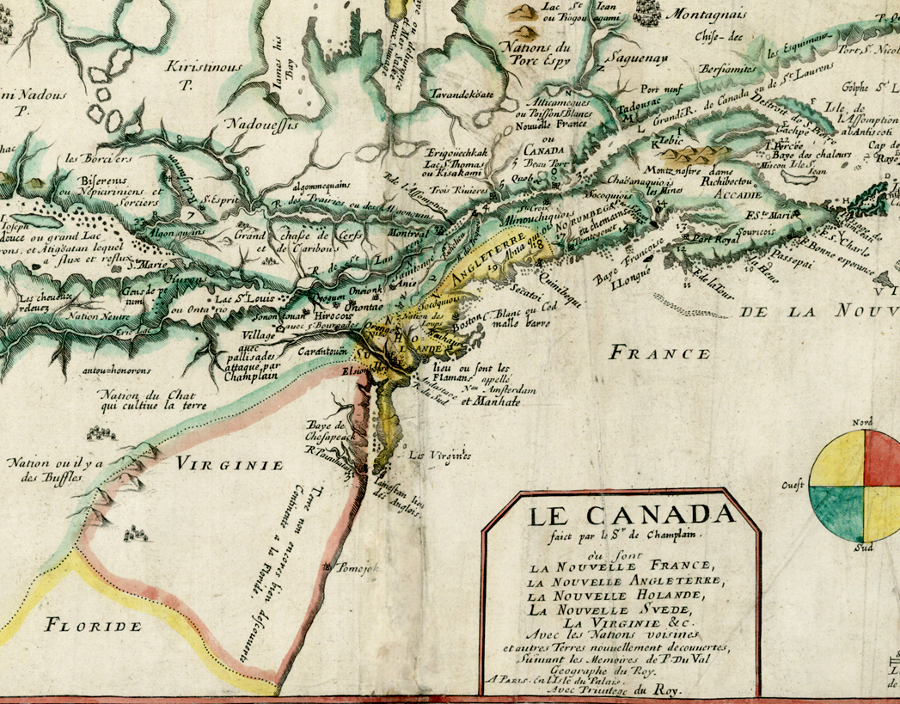Indian Land Claims
|
The English were well aware that Virginia was already occupied by humans when the colonists first arrived in 1607. Since the early 1500's, ships with captains from various nations had interacted with Native Americans in the Chesapeake Bay area.
Virginia was not "unoccupied" or "empty," and John Smith's map identified numerous towns on the shorelines of the Virginia rivers. The English understood that the Native Americans had their own government in Virginia. Powhatan defined his capital to be at Werowocomoco, though the English re-named the river the natives called Pamaunke after the Duke of York. Many of the place names of Virginia are based on the place names used by the Algonquian-speaking tribes, such as Chesapeake, Occoquan, and Accomack. Many Algonquian names have been applied to places west of the Fall Line, such as the Roanoke River and Powhatan County. Some of the more-appropriate place names remain, however, including Manakin in Goochland County just upstream from Richmond.
By right of prior settlement, Native Americans could claim ownership of Virginia. However, there are other criteria for determining ownership. As English colonists arrived and the population of "tassantassas" (foreigners) grew, Native Americans were unable to maintain control over the land through either military or legal processes.
At times, the English just finessed the native land claims, ignoring them while granting patents (legal deeds for ownership) to portions of Virginia to European settlers. The English justified such actions because the lands were unoccupied, and perhaps because the tribes were not "civilized" or Christian. At other times, when the English wanted to avoid military conflict with the tribes, the land claims of the Native Americans by right of prior settlement were also considered in Virginia.
|
|
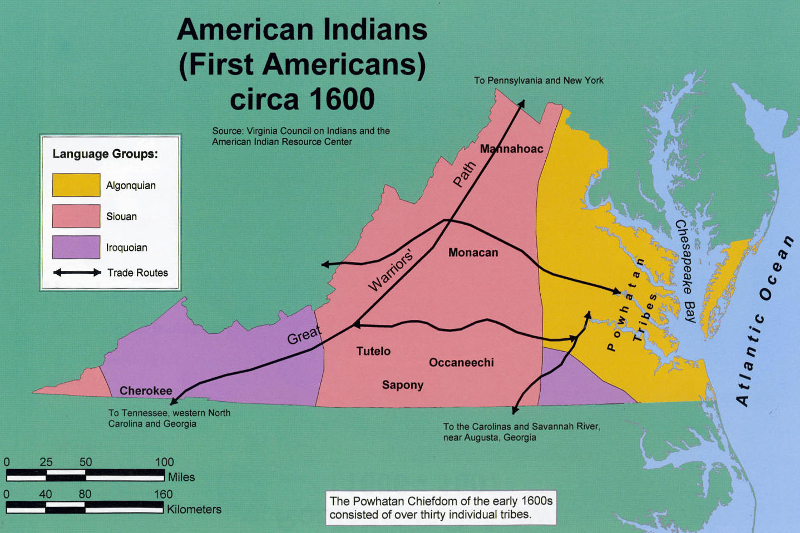
areas dominated by different language groups in 1600
Source: Virginia Geographic Alliance,
An Atlas of Virginia (Map 26)
Measuring actions in the past by standards of the present, an anachronistic approach described as "presentism," can create misleading impressions of morality and legality. The occupation of Virginia by European colonists in the 1600's was legal, based on English law at that time.
- Of course, if English colonization in the 1600's was measured by the Native American equivalent of English common law, a different conclusion could be reached. The morality of the behavior of English colonists in the 1600's should be assessed as a different question than the legality of occupation.
- English behavior in Virginia could be compared to Spanish, Dutch, and French interactions in their North American colonial settlements. In addition, a comparison of colonists' actions vs. the moral teachings of that era may illuminate how the temptation to seize land in Virginia affected the moral guidance from English religious leaders of that time. However, remember that the kings of England were the supreme head of the Church of England as well as the head of state. During Virginia's colonial period, kings and queens could make final judgments on both civil and moral issues.
When Virginia was settled, international law was even looser than it is today... which is still very loose. More than 60 years after the founding of the United Nations, enforcement of most legal constraints are limited to the boundaries of a single nation. Within many nations, the power of the national government is limited through either custom or overt political resistance. (In the late 1950's, the state government of Virginia pursued "massive resistance" to an order of the US Supreme Court to desegregate schools.) Economic sanctions - and occasionally military power - still substitute for peaceful enforcement of international decisions when one country refuses to comply voluntarily with a decision by an international body such as the World Trade Organization, World Court, Security Council/General Assembly of the United Nations, etc.
Even in the 1600's, however, the nation states of Europe had established procedures for minimizing armed conflicts while permitting economic plunder of the New World. At sea, during declared wars rulers would issue "letters of marque" authorizing private ships to seize commercial ships from another country. Once peace was declared, however, such seizures were treated as piracy... until the next war.
European countries traditionally established their legal claims to different parts of North America by right of discovery or by right of conquest. To establish legal ownership of colonies in North America, according to European law, actual occupation of new territory was essential in addition to discovery or conquest. Paper claims to territory, not supported by occupation, were not honored by European competitors.
That was one reason Virginians were quick to sail north and destroy a French colony in 1613 at St. Sauveur on Mount Desert Island, in what is now Acadia National Park. Eliminating the French settlement minimized the potential of a successful French claim to occupy lands also claimed by England, but still unoccupied by either nation along the Atlantic Coast. Conflict between the French and English settlers on the Atlantic coastline continued for 150 years, until the English finally expelled the French from all but two tiny islands.1
The English approach to acquiring Native American land and establishing English law to deal with new colonial situations was different from the Spanish and French approaches. The European nations used gifts/bribery as a vehicle to obtain Native American permission to occupy various areas.
At the same time, some tribes were quite willing to sell specious claims to
lands traditionally occupied by rival groups. Three separate groups sold Kentucky
to the colonists. The 1768 Treaty of Fort Stanwix extinguished the Iroquois
claim, the 1774 Treaty of Camp Charlotte extinguished Shawnee and Mingo claims,
and the 1775 Treaty of Sycamore Shoals extinguished claims of some of the Cherokee
- though Dragging Canoe pointed out that the land would be "dark and difficult
to settle" because force would still be required to ensure recognition
of the treaties. Of the three treaties, the Iroquois got the best deal, because
they had never controlled the Kentucky territory.2
As described in one scholarly book review of colonial law:3
- Europeans and Indians borrowed each other's law; like European societies, Native American societies were law-based. The uncompromisingly harsh Spanish legal system was infused with religious concepts and Spain forcibly attempted to impose its laws upon Indians, whom they believed to be racially inferior. Spaniards tried to convert Indians to Christianity or to enslave them, but Indians resisted and eventually made the legal system work for them.
- Native Americans also successfully resisted French laws--whereupon, the French, assuming the roles of good fathers, became less demanding and more receptive to Native American ways. The French found a "middle ground" by willingly negotiating with Indians, raising gift-exchanging to an art.
- The English, a commercial people, located their middle ground in trade; they introduced the concept of commodities, under which everything was a commodity to be exchanged. To further the prospects of trade and peace, the English, who did not rigorously attempt to force their legal system on Native Americans, negotiated treaties and exchanged gifts with them.
Some native claims in Virginia were extinguished through negotiation, and several treaties were signed by Virginia governors. The Powhatans were, in the end, overwhelmed not by law, but by depopulation through disease/warfare. Waves of English immigrants filled the land once hunted/fished/farmed by the Algonquians, Monacans, and other tribes.
There was Native American resistance. After Powhatan died, Opechancanough led two military assaults on the English settlements in 1622 and 1644. Opechancanough recognized that the English were not just short-term occupants of a small slice of the Powhatan territory, but would physically displace the tribes and dramatically alter their culture. The Powhatan fight to preserve their "way of life" failed, and the capacity of one leader to operate as a "paramount chief" was destroyed after the 1644 attack. The English burned all the Native American cornfields they could find, and the reduction of food forced the Powhatan tribes into submission.
The English had to consider the land claims of other Native American groups besides the Powhatan tribes, however. Powhatan ruled only between the Fall Line and the Atlantic Ocean, south to the Blackwater River and today's Virginia Beach and north to Potomac Creek and Aquia Creek. (He also dominated those tribes on the Eastern Shore, which could be reached only by canoe until the Europeans brought the new technology of sailing ships.)
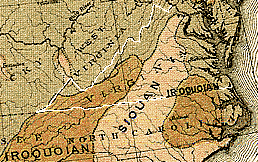 Tribes belonging to the Siouan and Iroquoian linguistic groups occupied the area between the Fall Line and the Blue Ridge. Most of the tribes west of the Fall Line, in the Virginia Piedmont and apparently in the Valley of Virginia west of the Blue Ridge, spoke languages belonging to the Siouan linguistic group.
Tribes belonging to the Siouan and Iroquoian linguistic groups occupied the area between the Fall Line and the Blue Ridge. Most of the tribes west of the Fall Line, in the Virginia Piedmont and apparently in the Valley of Virginia west of the Blue Ridge, spoke languages belonging to the Siouan linguistic group.
John Lederer, who wrote a journal about his explorations in 1669-70, was able to speak at least some of the Siouan languages. He recognized the capacity of the Native Americans to understand legal concepts:4
- Though they want those means of improving Humane Reason, which the use of Letters affords us; let us not therefore conclude them wholly destitute of Learning and Sciences: for by these little helps which they have found, many of them advance their natural understandings to great knowledge in Physick, Rhetorick, and Policie of Government: for I have been present at several of their Consultations and Debates, and to my admiration have heard some of their Seniors deliver themselves with as much Judgement and Eloquence as I should have expected from men of Civil education and Literature.
The Cherokee in southwestern Virginia spoke a distinct language that was most closely related to the Iroquois. The Meherrin and the Nottoway tribes in southeastern Virginia, who lived along the rivers that still bear their name, also spoke languages belonging to the Iroquoian linguistic group. The Meherrin and Nottoway were separated from the Iroquoian-speaking tribes to the north and the west, but were physically close to other Iroquoian-speaking tribes in North Carolina, especially the Tuscarora.
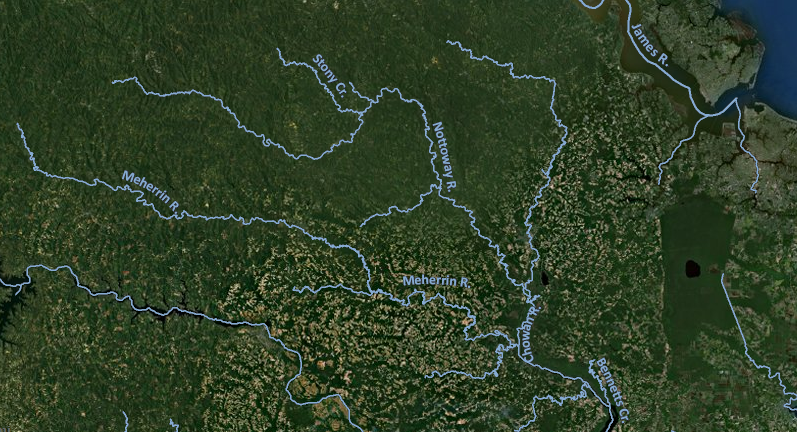
the Meherrin and Nottoway tribes lived in the Chowan River/Albemarle Sound watershed,
separate from the Chesapeake Bay watershed controlled by the paramount chiefdom of Powhatan
Source: ESRI,
ArcGIS Online
Five Iroquois tribes in New York, from the Mohawks on the east to the Senecas on the west, formed a powerful confederacy or "league." They deterred English colonists in Massachusetts from expanding west of the seacoast. The Iroquois threatened their Native American neighbors to the south; the northern tribes would send hunters on long expeditions down into the Virginia Piedmont and the Shenandoah Valley in the fall, where deer, turkeys, and other game were more plentiful than in the tribes' local area.
The hunters on these expeditions were not committed to peace with the Virginian colonists, and often these "raids" created alarm among the English settlers on the frontier. The military threat of Native American tribes to the western edge off Virginia (modern West Virginia) continued throughout the 1600's and 1700's, until the Treaty of Greenville was signed in 1795 after General "Mad Anthony" Wayne won the Battle of Fallen Timbers in Ohio.
The Indian land claims in Virginia were extinguished by a series of battles, treaties, and purchases. Twice, reservations were set aside for Native Americans in Virginia with white trustees responsible for court interactions involving land ownership issues and conflicts with adjacent neighbors, but later those reservations were dissolved officially so the lands could be sold to non-natives. The Accomac tribe lost its Gingaskin Reservation in Northampton County when termination began in 1812. The Nottoway reservation was terminated in 1824.5
Only two tribes in Virginia have managed to maintain continuous ownership of a portion of their ancestral lands for the last 400 years, as defined by English/American law. The Pamunkey and Mattaponi reservations in King William County are not the only lands in Virginia owned by tribal organizations now - but all the other sites involve lands that passed out of Native American ownership, until being re-acquired relatively recently.
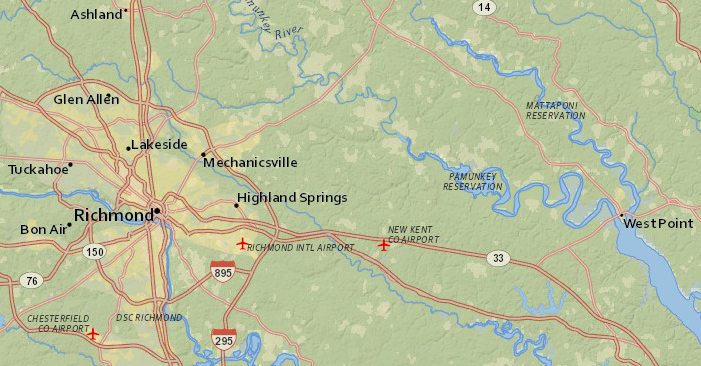
the Pamunkey Reservation was the only Native American land claim in Virginia that never disappeared over the last 400 years
(and the Mattaponi Reservation was later carved out of the Pamunkey territory)
Source: ESRI,
ArcGIS Online
References
1. "The First Acadians," Acadian Culture in Maine, National Park Service (posted online by University of Maine), 1994, http://acim.umfk.maine.edu/first_acadians.html (last checked September 26, 2013)
2. Lowell Harrison, A New History of Kentucky, University Press of Kentucky, 1997, p.26, http://books.google.com/books?id=FdTIIEZ1k2QC; Woody Holton, "The Ohio Indians and the Coming of the American Revolution in Virginia," The Journal of Southern History,
Volume 60, Number 3 (August 1994), http://www.jstor.org/stable/2210989 (last checked September 30, 2013)
3. Gaspare J. Saladino, review of Peter Charles Hoffer's Law and People in Colonial America: Revised Edition, H-Law blog, January 1999, http://www.h-net.org/reviews/showrev.php?id=2618 (last checked September 26, 2013)
4. Sir William Talbot Baronet, The Discoveries Of John Lederer, In three several Marches from Virginia, To the West of Carolina, And other parts of the Continent: Begun in March 1669, and ended in September 1670. Together with A General Map of the whole Territory which he traversed, 1672, posted online by University of North Carolina, p.6, http://rla.unc.edu/archives/accounts/lederer/lederertext.html (last checked September 26, 2013)
5. Helen C. Rountree, "The Termination and Dispersal of the Nottoway Indians of Virginia," The Virginia Magazine of History and Biography, Volume 95, No. 2 (April 1987), p.205, http://www.jstor.org/stable/4248941 (last checked September 26, 2013)
"Indians" of Virginia - The Real First Families of Virginia
Virginia Places


